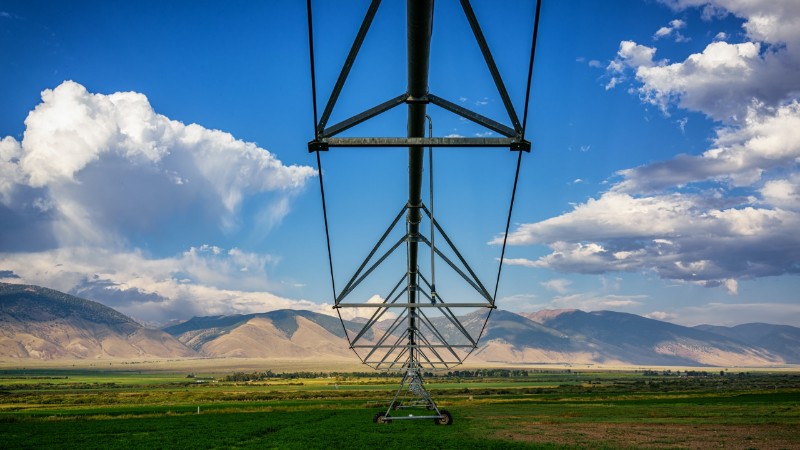What Is The Best Way To Conserve And Manage Water On Your Farm?

Water is a crucial component for the survival and growth of crops on a farm. Proper conservation and management of this precious resource is essential for the success and sustainability of agricultural operations. With the increasing population and demand for food, combined with the effects of climate change, it has become imperative to find the best ways to conserve and manage farm water resources. This article will explore the various methods available for conserving and managing water and help farmers make informed decisions to ensure the long-term viability of their operations.
There are various ways to conserve and manage water on the farm, ranging from traditional methods such as rainwater harvesting and irrigation efficiency to more advanced techniques like precision agriculture and soil moisture monitoring. Each method has advantages and disadvantages, and choosing the right one depends on several factors such as location, climate, type of crops grown, and available resources. By carefully considering these factors and exploring the different methods available, farmers can create a water management plan tailored to their unique needs and helps conserve this precious resource for future generations.
Importance of water conservation in agriculture
Water conservation is important in agriculture as it is essential for growing crops and raising livestock. Water availability is a major factor in determining the productivity of a farm, and farmers must take steps to conserve water to ensure the long-term sustainability of their operations.
Water conservation is especially important in areas where water is scarce or with increasing demands for water from other sources, such as urban areas. In these regions, farmers must take extra steps to conserve water or risk losing access to the water they need to grow crops and raise livestock.
Additionally, water conservation is important because of its impact on the environment. By reducing water use, farmers can help reduce the amount of water withdrawn from rivers, lakes, and aquifers, helping preserve these resources for future generations.
How to conserve and manage water on your farm?
Conserving and managing water on a farm is critical for ensuring the sustainability and success of agricultural operations. Here are several ways farmers can conserve and manage water resources on their farms.
Irrigation efficiency
Irrigation efficiency is critical to conserving and managing water on a farm. By using efficient irrigation systems, farmers can ensure that water is delivered to their crops most effectively and efficiently as possible, reducing water waste. Several types of irrigation systems are available, each with advantages and disadvantages.
Drip irrigation is one of the most efficient forms of irrigation. In this system, water is delivered to the roots of the crops through a series of small, slowly dripping emitters. This method reduces water wastage by minimizing runoff and evaporation and delivering water directly to the roots of the crops where it is needed. Sprinkler irrigation and micro-irrigation are other forms of efficient irrigation that can be used on a farm. Sprinkler irrigation uses a network of pipes and sprinklers to deliver water to crops. In contrast, micro-irrigation uses a system of small tubes to deliver water directly to the roots of the crops.
By choosing the right irrigation system and ensuring that it is used efficiently, farmers can conserve water and improve their yields. However, it is important to note that irrigation efficiency is not just about choosing the right system but also about properly maintaining and managing the system and regularly monitoring and adjusting it to ensure it works effectively.
Soil moisture monitoring
Soil moisture monitoring is a valuable tool for conserving and managing water on a farm. By using soil moisture sensors, farmers can measure the moisture levels in their soil, which can help them make informed decisions about when and how much water to give their crops. This technology can help farmers conserve water by avoiding over-watering, which can lead to water wastage, and by reducing the risk of water stress, which can reduce crop yields.
Soil moisture sensors come in various forms, including capacitance sensors, neutron probes, and time-domain reflectometry sensors. Each type of sensor has its advantages and disadvantages, and choosing the right one depends on the farm’s specific needs. Capacitance sensors are the most widely used and are relatively low-cost, while neutron probes provide a more accurate measurement of soil moisture levels but are more expensive. Time-domain reflectometry sensors use electromagnetic waves to measure soil moisture and are useful for deep-rooted crops.
In addition to choosing the right type of sensor, it is important to place and maintain the sensors to ensure accurate readings. Soil moisture monitoring can also be combined with other technologies, such as precision agriculture, to optimize farm water use and ensure agricultural operations’ sustainability and success. Using soil moisture monitoring, farmers can make informed decisions about when and how much water to give their crops, conserving water and improving their yields.
Precision agriculture
Precision agriculture is a farming method that uses technology to optimize the use of resources, including water. By using precision agriculture, farmers can make more informed decisions about when and how much water to give their crops, reducing water wastage and improving yields. Precision agriculture involves various technologies, including GPS, remote sensing, and data analysis.
One of the key components of precision agriculture is GPS technology. GPS allows farmers to map their fields and create detailed, accurate maps that guide planting, fertilization, and irrigation. Remote sensing technology, such as aerial imagery and satellite imagery, can also be used to gather data about the health and growth of crops, which can help farmers make informed decisions about when and how much water to give their crops. Data analysis is another critical component of precision agriculture, as it allows farmers to process and analyze the vast amounts of data gathered by GPS and remote sensing technology.
Using precision agriculture, farmers can conserve water by applying it only where and when it is needed, reducing water wastage and improving yields. However, it is important to note that precision agriculture is not a one-size-fits-all solution, and the specific technologies and techniques used will vary depending on each farm’s specific needs and resources. Precision agriculture can be complex and requires a good understanding of technology, data analysis, and farm management, so it may be necessary to seek the help of a precision agriculture expert.
Rainwater harvesting
Rainwater harvesting is a technique used to conserve and manage water on a farm. This method involves collecting and storing rainwater, which can then irrigate crops, reducing the need for other water sources such as wells or streams. This can be especially important in areas with limited water resources or during periods of drought.
Rainwater harvesting systems can be simple or complex, depending on the needs of the farm. A basic system can be as simple as placing a container under a gutter to catch rainwater, while a more complex system might include a series of tanks and pumps to store and distribute water to crops. To be effective, rainwater harvesting systems must be properly designed, installed, and maintained. This includes ensuring that the tanks are of sufficient size to store enough water to meet the needs of the crops and that the system is properly sealed to prevent contamination.
Rainwater harvesting can be an important part of a farm’s comprehensive water conservation and management plan. When combined with other methods, such as soil moisture monitoring and precision agriculture, rainwater harvesting can help farmers conserve water and improve their yields. Additionally, by reducing the need for other water sources, rainwater harvesting can also help protect local water resources, ensuring the long-term sustainability of agricultural operations.
Crop selection and rotation
Crop selection and rotation are important components of water conservation and management on a farm. By carefully choosing crops and rotating them regularly, farmers can reduce the need for irrigation and conserve water. This is because different crops have different water requirements, and rotating crops can help ensure that the soil remains healthy and retains moisture.
When selecting crops, it is important to consider factors such as the water requirements of the crops, the climate and soil conditions, and the farm’s specific needs and goals. For example, drought-resistant crops, such as maize or sorghum, can be a good choice for farms in dry regions, as they require less water to grow. Similarly, crops well-suited to the local climate and soil conditions are more likely to thrive, reducing the need for irrigation and conserving water.
In addition to crop selection, crop rotation is an important water conservation and management tool. By rotating crops, farmers can improve the health of the soil, reduce the need for irrigation, and conserve water. This is because different crops can have different effects on the soil, with some crops improving soil structure and fertility while others can degrade the soil and increase the need for irrigation. By rotating crops, farmers can ensure that the soil remains healthy and retains moisture, reducing the need for irrigation and conserving water.
Water-saving practices
Water-saving practices are techniques that farmers can use to conserve water and reduce waste. These practices minimize the water used for irrigation and other purposes while allowing crops to thrive. Some common water-saving practices include using drought-resistant crops, reducing the water applied to crops, and using more efficient irrigation methods.
Drought-resistant crops, such as certain varieties of maize or sorghum, can be a good choice for farmers looking to conserve water. These crops are specifically bred to require less water to grow and can help reduce the amount of irrigation required. Reducing the amount of water applied to crops can also help conserve water, as long as it is done carefully to ensure that the crops receive enough water to grow and produce a good yield.
More efficient irrigation methods, such as drip irrigation and micro-irrigation, can also help conserve water. These methods allow farmers to apply water directly to the roots of the crops, reducing the amount of water lost to evaporation and runoff. Additionally, these methods are typically more precise than other irrigation methods, allowing farmers to apply water exactly where and when it is needed, reducing water waste.
By using water-saving practices, farmers can conserve water, reduce waste, and improve the health of their crops. These practices are an important part of a comprehensive water conservation and management plan and can help ensure the long-term sustainability of agricultural operations.
Conservation tillage
Conservation tillage is a farming practice that involves minimizing soil disturbance to conserve water and improve soil health. Unlike traditional tillage practices, which involve plowing and cultivating the soil, conservation tillage involves leaving the soil intact and using practices such as minimum tillage or no-till to minimize soil disturbance.
The benefits of conservation tillage are numerous, including reduced soil erosion, improved soil structure and fertility, and increased water conservation. By leaving the soil intact, conservation tillage helps preserve the soil’s structure, increasing its ability to retain moisture. This can reduce irrigation requirements and help ensure water is used more efficiently.
Additionally, conservation tillage can help improve soil health by reducing the amount of organic matter exposed to the air, resulting in improved soil structure and fertility. This, in turn, can result in increased crop yields and improved water efficiency. By reducing soil disturbance, conservation tillage can also help reduce the amount of carbon released into the atmosphere, which can help mitigate the effects of climate change.
By implementing these methods, farmers can conserve and manage their water resources, improving the sustainability and success of their operations. However, it is important to note that the best approach will vary depending on each farm’s specific conditions and resources and may require the help of a water management expert.

